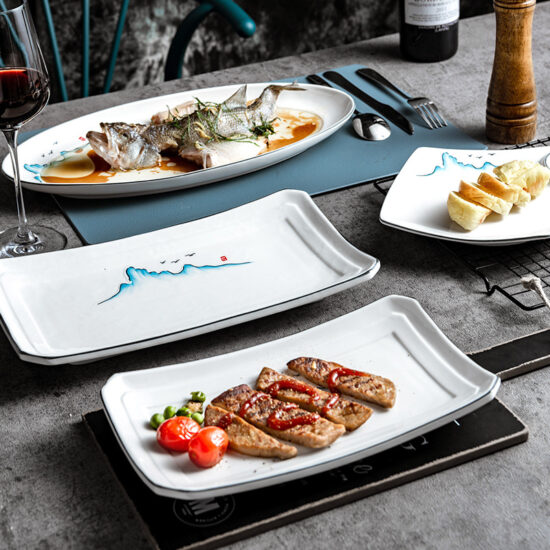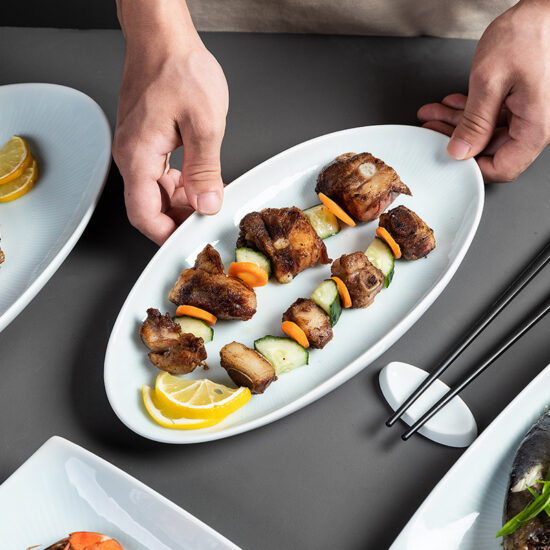bob@nbdho.com
Ceramic Plates vs. Glass, Stainless Steel, and Plastic: Which Tableware is Best?
Ceramic Plates vs. Glass, Stainless Steel, and Plastic — Which Is Better?
Introduction
Choosing the right type of tableware is more than just about appearance—it involves factors like durability, health safety, sustainability, and cost-effectiveness. Among the popular materials available, ceramic, glass, stainless steel, and plastic each offer distinct advantages and disadvantages. This article compares these four materials to help you determine which is best for your home, restaurant, or wholesale tableware selection.
1. Aesthetic Appeal
-
Ceramic Plates
Ceramic offers a wide range of colors, textures, and patterns—from rustic handmade designs to high-gloss modern finishes. Ideal for both casual and fine dining aesthetics. -
Glass Plates
Transparent and elegant, glassware gives a clean and sophisticated look. However, design options are more limited than ceramic. -
Stainless Steel Plates
Sleek and utilitarian, but not typically considered elegant. Best suited for canteens, outdoor settings, or minimalistic styles. -
Plastic Plates
Available in many bright colors, but often considered cheap-looking and less refined—mainly used for informal or disposable settings.
✅ Winner: Ceramic, for versatility and visual appeal across different dining settings.
2. Durability
-
Ceramic
Durable with proper handling, but can chip or crack if dropped. High-fired stoneware and porcelain are stronger and more chip-resistant. -
Glass
Breakable and prone to cracking or shattering on impact. Tempered glass offers slightly better durability. -
Stainless Steel
Extremely durable, shatterproof, and long-lasting. Great for rugged environments. -
Plastic
Doesn’t break easily, but scratches, warps, or stains over time—especially with hot foods.
✅ Winner: Stainless Steel, with ceramic as a close second when handled carefully.
3. Food Safety & Health
-
Ceramic
Safe and non-reactive when properly glazed. Certified food-grade ceramics are lead-free and non-toxic. -
Glass
Non-porous and non-reactive. Very hygienic if not broken or chipped. -
Stainless Steel
Non-reactive for most foods, though highly acidic foods may cause some leaching if the alloy is low-grade. -
Plastic
Often contains BPA or other harmful chemicals if not labeled food-safe. Prone to absorbing odors and staining.
✅ Winner: Ceramic or Glass, for their non-toxic and non-reactive nature.
4. Heat Resistance & Microwave Use
-
Ceramic
Excellent heat resistance. Microwave- and oven-safe if labeled appropriately. -
Glass
Also heat-resistant, but can break due to thermal shock. -
Stainless Steel
Not microwave-safe. Can be used in ovens, but usually not ideal for reheating meals. -
Plastic
Many plastics are not microwave-safe. Can melt or release toxins under high heat.
✅ Winner: Ceramic, for its versatility with microwave and oven use.
5. Sustainability and Environmental Impact
-
Ceramic
Long-lasting and recyclable. Environmentally friendly when produced responsibly. -
Glass
Fully recyclable. Can be reused many times without degrading. -
Stainless Steel
Highly recyclable and durable, with minimal waste over time. -
Plastic
Least sustainable. Often single-use or wears out quickly, contributing to pollution.
✅ Winner: Stainless Steel and Ceramic, both offer sustainable long-term use.
6. Cost Considerations
-
Plastic – Cheapest upfront, but low lifespan.
-
Glass – Moderately priced, but fragile.
-
Ceramic – Affordable and offers high value for its quality.
-
Stainless Steel – Higher initial cost, but extremely long-lasting.
✅ Best Value: Ceramic, balancing quality, performance, and price.
Conclusion
| Material | Aesthetics | Durability | Safety | Microwave Use | Sustainability | Cost-Effectiveness |
|---|---|---|---|---|---|---|
| Ceramic | ⭐⭐⭐⭐⭐ | ⭐⭐⭐⭐ | ⭐⭐⭐⭐⭐ | ⭐⭐⭐⭐⭐ | ⭐⭐⭐⭐ | ⭐⭐⭐⭐ |
| Glass | ⭐⭐⭐⭐ | ⭐⭐ | ⭐⭐⭐⭐⭐ | ⭐⭐⭐ | ⭐⭐⭐⭐ | ⭐⭐⭐ |
| Stainless Steel | ⭐⭐ | ⭐⭐⭐⭐⭐ | ⭐⭐⭐⭐ | ❌ | ⭐⭐⭐⭐⭐ | ⭐⭐⭐⭐ |
| Plastic | ⭐ | ⭐⭐ | ⭐ | ⭐ | ⭐ | ⭐⭐⭐⭐⭐ |
For most dining needs—especially in hospitality, restaurants, and retail—ceramic plates offer the best balance of appearance, functionality, safety, and cost.
At [Your Company Name], we specialize in wholesale, OEM, and custom ceramic plates suitable for every market. Whether you’re outfitting a five-star hotel or launching a new product line, we provide ceramic solutions that combine tradition with innovation.

